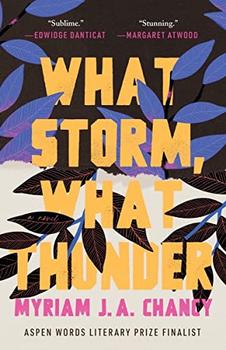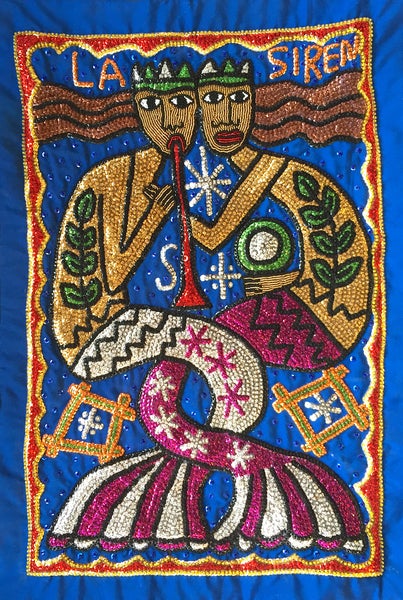Summary | Excerpt | Reviews | Beyond the Book | Read-Alikes | Genres & Themes | Author Bio

This article relates to What Storm, What Thunder
In the back matter of What Storm, What Thunder, author Myriam J. A. Chancy cites paintings by Trinidadian artist LeRoy Clarke (who passed away in July 2021) as a major inspiration for her novel. Clarke created a cycle of nearly a hundred paintings about Haiti, many of them depicting the 2010 earthquake. Similarly, Chancy was moved to create fiction to immortalize the hundreds of stories that people told her about their experiences with this disaster. Other Haitians have explored the trauma surrounding the earthquake in visual art mediums.
Haitian art enjoys a long tradition inspired by cultural crosscurrents. Whether in museums, galleries, isolated rural studios or urban alleyways, Haitian art reflects a dynamic culture born of unique historic and geographic elements. Some artists blend traditional vodou themes with biblical iconography. Others depict agrarian and market scenes, or the island's vibrant flora and fauna.
Here's a quick look at some Haitian styles of art.
Painting
 An art program in Port-au-Prince called Centre d'Art began in 1944 and has nurtured generations of Haitian artists. Although much was destroyed in the earthquake, a new crop of artists continues to train and exhibit in this community. With grassroots and international support, the Centre d'Art is restoring damaged paintings and preserving Haiti's art for future generations. Common themes and styles in paintings include religious rites (often blending vodou's African roots with Christian iconography), nature, people at work, portraiture and abstracts. More recently, images connected with politics, natural disasters and healing are evident.
An art program in Port-au-Prince called Centre d'Art began in 1944 and has nurtured generations of Haitian artists. Although much was destroyed in the earthquake, a new crop of artists continues to train and exhibit in this community. With grassroots and international support, the Centre d'Art is restoring damaged paintings and preserving Haiti's art for future generations. Common themes and styles in paintings include religious rites (often blending vodou's African roots with Christian iconography), nature, people at work, portraiture and abstracts. More recently, images connected with politics, natural disasters and healing are evident.
A variety of paintings can be viewed on the Centre d'Art's website.
Textile Art

The community cooperative Art Matenwa is a rural arts and education center in the La Gonâve region that began with a core group of seven women over 20 years ago, and has expanded to train many younger artists. Silk painting, screenprinting, embroidery and "drapo" designs (sequined and beaded flags) are handmade and distributed internationally. The artists generate income from the art to help support their families.
A selection of drapo pieces can be viewed and purchased through Art Matenwa.
Metal Art
 Haiti's tradition of metal art made from recycled steel barrels dates back to the 1950s and continues today. Steel drums that once held oil are flattened, and then manual tools are used to craft decorative shapes and patterns in the metal. Common themes include birds, flowers, trees, the sun, mermaids and angels.
Haiti's tradition of metal art made from recycled steel barrels dates back to the 1950s and continues today. Steel drums that once held oil are flattened, and then manual tools are used to craft decorative shapes and patterns in the metal. Common themes include birds, flowers, trees, the sun, mermaids and angels.
More information about the process of creating these pieces, along with a variety of examples, can be found on the Haiti Metal Art website.
Art, like literature, lives on as testimony to the past, and as an enduring process through which humans try to make sense of the world, and our existence.
Filed under Music and the Arts
![]() This "beyond the book article" relates to What Storm, What Thunder. It originally ran in January 2022 and has been updated for the
August 2022 paperback edition.
Go to magazine.
This "beyond the book article" relates to What Storm, What Thunder. It originally ran in January 2022 and has been updated for the
August 2022 paperback edition.
Go to magazine.
Your guide toexceptional books
BookBrowse seeks out and recommends the best in contemporary fiction and nonfiction—books that not only engage and entertain but also deepen our understanding of ourselves and the world around us.